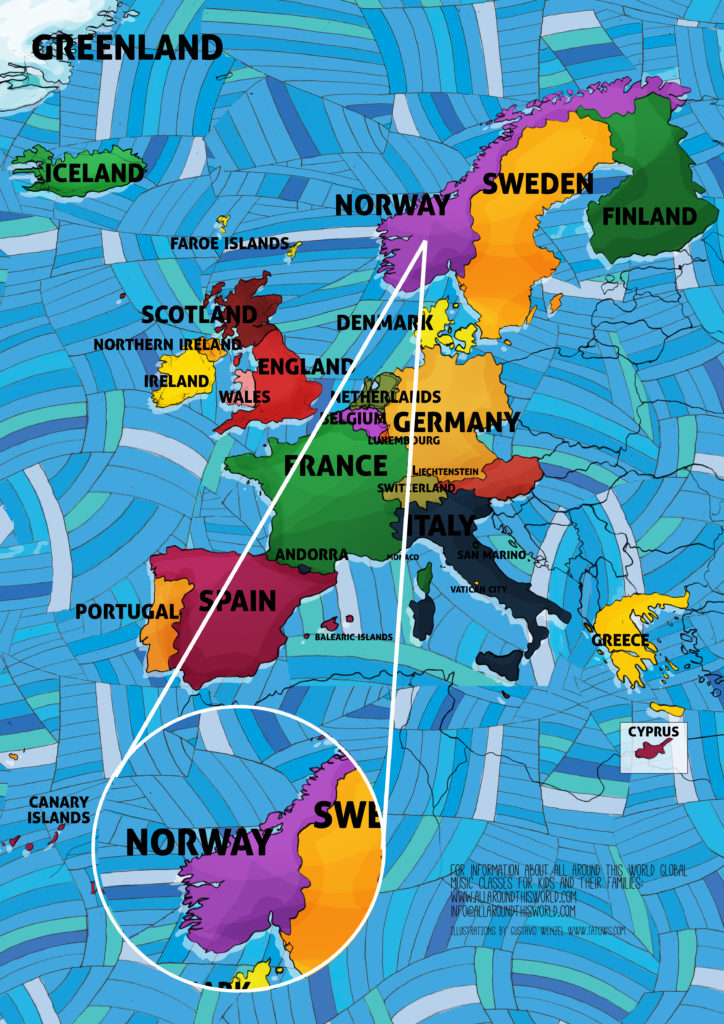Our favorite move by far in the Norwegian Halling dance is the Snuskverna etter Ola Øde. Watch this video of a dancer from the FRIKAR ensemble doing the move. Wow. It’s obviously a breakin’ move from the 1980s in the Bronx. Except, remember, the Hallingdans is documented to be a northern European dance that’s 2,500 years old. The first breakdance? Double wow.
Tag Archives | Norway
FRIKAR is freakin’ awesome
In this video we have a grand time introducing kids to Norway’s awesome ancient Halling dance, but of course we can’t begin to compare to the real deal. If you really want to learn the halling dance, follow along with the FRIKAR dance company’s instructional videos:
gangelag| rebnetaket | helrulla | tåtaket | sviving | helikopter | fotkross | heldehopp | rulle kråke | kast over geitè.
Enjoy!
Hallingdans is 2,500 Years Young
The halling dance (Hallingsans) is the oldest documented dance in all of Northern Europe; there are pictures of halling dancers painted on caves that are potentially 2,500 years old. The halling dance is acrobatic, competitive and a wonder to see. Dancers leap, prance, spin on their heads and generally try the push the boundaries of what is physically possible and, simultaneously, graceful. Check out this video of Hallgrim Hansegård‘s performance of a halling dance — it’s extraordinary.
Mary Boine’s Jammin’ Joik
The Sami people are the indigenous inhabitants of Arctic lands in the far northernmost parts of Sweden, Norway, Finland and Russia’s Kola Peninsula. Today the Sami are known for their fishing, fur trapping and reindeer herding, and also for their tradition of sitting in saunas. (Sounds lovely.) Mari Boine, who you’ll see in this video, is Norway’s best known Sami vocalist. Her otherworldly “joik” vocals and her outspoken support of the Sami people have made her a formidable artistic and political presence in Scandinavia.
Start a Stev dance craze
Norway’s North Germanic folk music focuses on two kinds of songs — kvad (ballads) and stev, which are poetic songs, most of which are several centuries old. Some researchers have concluded that stev originally accompanied dances, though related dances are long lost. If that makes you sad, don’t mope — start your own new tradition by dancing along to the stev performed by in this video by Sondre Bratland and Kirsten Bråten Berg.
Fanitullen on a Norwegian Fiddle
Norwegian folk music is closely intertwined with the folk music of Denmark — as closely as the history of Norway is intertwined with that of Denmark, which is quite intertwined. (You knew Denmark ruled Norway from 1380 until the early 1800s, didn’t you?) As in Denmark, the primary instrument in Norway’s folk music is the fiddle; in Norway, the most distinctive fiddle is the Hardanger. In this video we watch distinctive fiddler Haakon Solaas from western Norway playing the folk song “Fanitullen.”
Norway tops the charts

This week in class we go north north north where we nest for a few days in Norway. There are a lot of intangible things that inspire us to go north to Norway, and over the course of the week we’re going to enjoy some of them — specifically Norwegian folk music and dance — but let’s start with statistics. We don’t usually quote from Wikipedia, but this paragraph, current at the time of this post, is hard to ignore: “Norway has had the highest Human Development Index ranking in the world since 2009. It also had the highest inequality-adjusted ranking until 2018 when Iceland moved to the top of the list. It is ranked first on the World Happiness Report for 2017 and ranks first on the OECD Better Life Index, the Index of Public Integrity, and the Democracy Index. Norway has one of the lowest crime rates in the world.” Yes? Ja!

